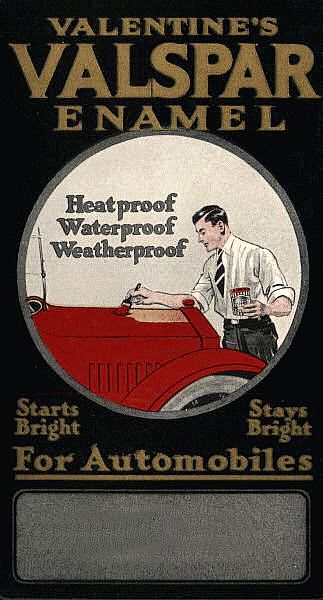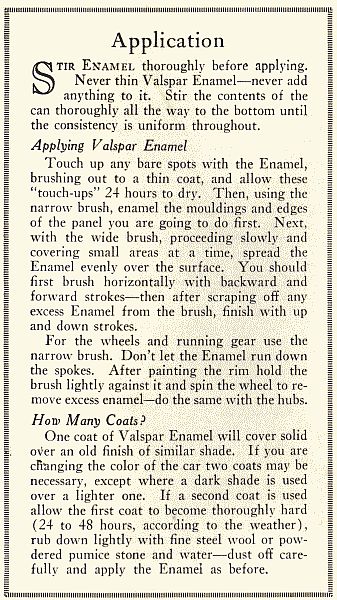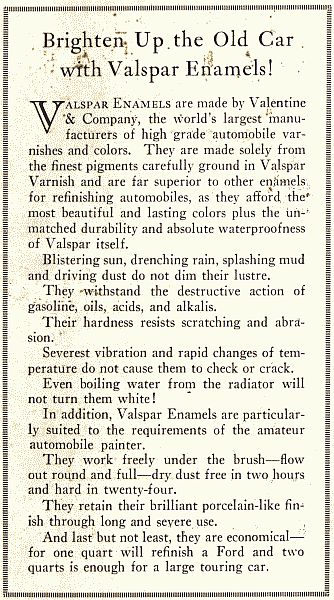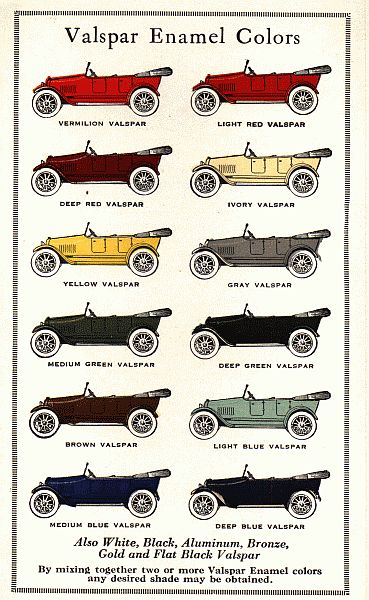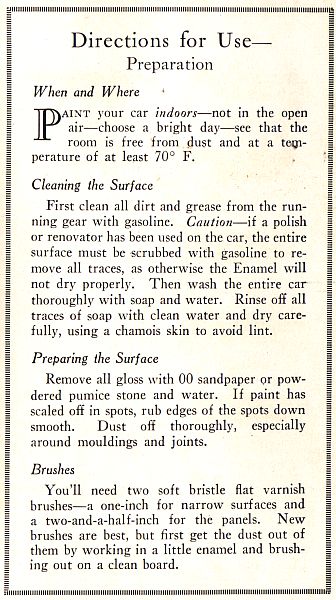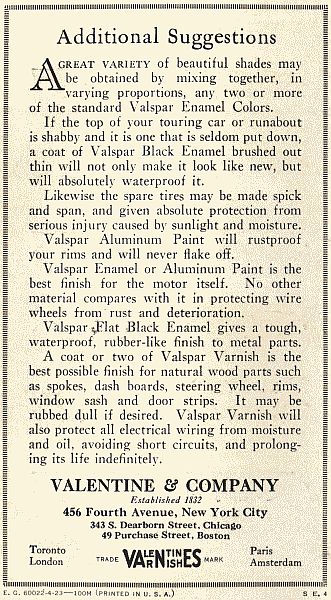|
The Stanley Motor Carriage Company used Valentine's Valspar Enamels to paint their cars. Depending on the year and model, Stanley offered a default color but their advertising literature indicated they would supply any Valspar color the customer desired for an additional charge. Reproduced below is a Valentine's Valspar Enamel brochure from the Stanley era. This brochure became the basis for the color selection when it became time to paint the car. Note that the car on the brochure's cover is being painted by hand using a brush. This was how cars were painted in that era. The paint was carefully applied with a fine bristle brush, and then when dry, hand rubbed and polished to a high shine. Even though the Stanley Twins had invented the air brush (a form of atomizing sprayer for artistic paints) the technology to paint a car using a variation of the air brush we now call the spray gun in a special paint booth had not been perfected for mass production.
The Model 735 Stanley received its first restoration in 1950 through 1952. At that time the car was painted a single color - gunmetal gray. Somehow the gray color in combination with the body styling gave the vehicle an uninteresting look. The automobiles of the second decade of the 20th century had lost much of their brightwork of brass and nickel and body colors had become subdued as well. Soon after the car was acquired and had entered the mechanical phase of the restoration thoughts of eventually restoring the body led to thoughts of attempting to match colors that Stanley would have had available. The task of locating actual color paint chip samples from the condensing era of Stanley cars commenced.
The first activity in trying to determine the shades of colors Stanley might have had available was to contact Valspar. Unfortunately Valspar did not have any color paint chip information from the initial years that they produced automotive paints. DuPont Automotive Refinishes, PPG ~ Pittsburgh Paints, and several other automotive paint manufacturers were contacted for color paint chip information without success. A search of the internet for automotive literature collectors did not turn up any leads as well. A check with the archivist at The Stanley Museum in Kingfield, Maine uncovered that no known color brochures or information was available. As only black and white photography was possible during the era of the Stanley, no color photos of the cars are known to exist. The guidance offered was basically that without historical documentation of actual colors used, any color selected that was appropriate for the era would be more than acceptable.
As a last resort a search was set up on eBay for anything that might come to online auction relating to Valspar or DuPont Dulux. Partway through the mechanical restoration a Kwik Koat color paint chip brochure from 1917 came up for auction and was successfully bid on. The search was continued and after 2-1/2 years a Valentine's Valspar Enamel Color brochure showed up for auction that was from the condensing era of Stanley cars. After the auction was won it was discovered that the seller had a pack of color brochures and negotiations for several more from his stock were completed. His brochures were found still wrapped in their original brown packaging at the back of an old hardware store that had closed. It was truly the ideal find since fading of the colors and damage to the brochures had not occurred.
Stanley offered Royal Green as the default color for 1918 Model 725 cars according to Stanley sales literature. It is unknown if the color was actually the Medium Green or the Deep Green color shown in the brochure. Alternatively the color might have been custom blended by Stanley or Valspar since as noted in the brochure any two or more colors could be blended to obtain a desired shade.
Choosing a color for the car was a bit of a dilemma. Being partial to the dark green shades Stanley painted their cars, dark green was an initial thought since it was the color the car probably was when it left the factory. The realization that there are a lot of green Stanleys about changed that idea as having "just another green Stanley" did not seem to be the answer. Perhaps blue would be an acceptable color? As it turns out a vast majority of condensing Stanleys were painted in dark shades of blue. Again, owning "just another blue Stanley" wasn't the solution especially considering that the blue shades which were appealing were in reality modern metallic flake colors and unacceptable on a 1918 Stanley for obvious reasons. In the initial years of production Stanley painted a majority of their cars various shades of red. The popularity of red seemed to fade after 1910 and few condensing Stanley cars are seen in shades of red. After seeing several red non-Stanley cars of the same era as the Stanley, and considering the eye-catching appeal of a red car with black fenders, one of the three shades of red from the Valentine's Valspar Brochure would be selected for the restoration along with the traditional black for the fenders and windshield.
With red having been chosen as the color for the restoration, one more decision had to be made; paint the car in the traditional Stanley manner or make some changes? The 1918 Stanley entered the body restoration phase in 2000 without the final colors having been selected other than "red". During the body restoration phase a black and white Stanley advertising photo of the car was used determine how the car might look in a red color scheme. To read about how the final two-tone red color scheme (similar to the two reds used on this web page) was decided along with how the car would be pin-striped, click on the NEXT arrow below. |
